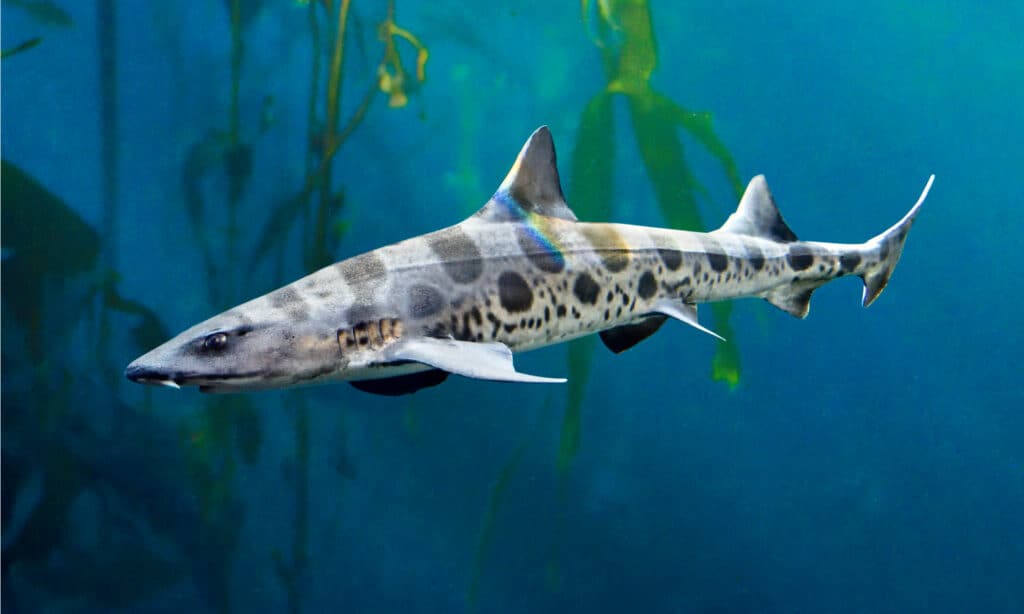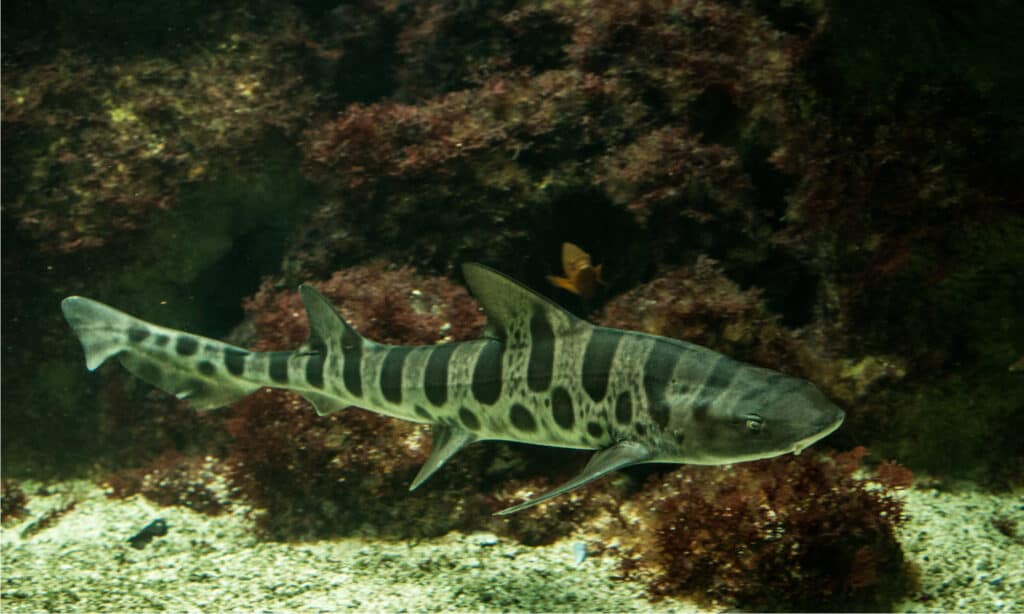Leopard sharks are a species of houndshark found in a handful of states across America. These sharks get their names from their black saddle-like stripes and large black spots over their backs. On average, leopard sharks grow as long as 3.9 to 4.9 feet (1.2 to 1.5 m), but specimens as large as 7 feet (2.13 m) have been recorded.
With the recent rise in shark attacks, it’s becoming more apparent just how dangerous these fish can be. And although leopard sharks are nowhere as large as great whites or other sharks notorious for attacking humans, they are still sharks. So, it’s a smart idea to figure out how likely you are to get attacked by one. Let’s find out just how dangerous or aggressive leopard sharks are.
Are Leopard Sharks Aggressive?

Barbara Ash/Shutterstock.com
Leopard sharks are one of the most unaggressive shark species. They are not large sharks and are known to avoid divers and snorkelers due to their wary natures. They prefer to swim away when humans come near and are very quick to do so.
Although these sharks live up to 30 years, they are not large or heavy, with the largest recorded specimen weighing just over 40 pounds.
Are Leopard Sharks Dangerous?

SunflowerMomma/Shutterstock.com
Leopard sharks are not considered dangerous animals. Apart from their timid and wary natures, they are easily spooked and pose no threat to humans. However, this doesn’t mean that they should be considered harmless. They have rows of teeth and will defend themselves if cornered, so it’s a good idea to stay away from them if encountered.
Has A Leopard Shark Ever Attacked A Human?

Jiri Hrebicek/Shutterstock.com
According to the International Shark Attack File, only one attack by a leopard shark has been recorded. The shark spotted a diver with a nosebleed and bothered her. Luckily, she wasn’t seriously injured. There have been a few other reported attacks by leopard sharks, but no other has been confirmed.
Are Leopard Sharks Friendly?
Leopard sharks in the wild have a reputation for being almost friendly to humans. In San Diego’s La Jolla, NBC San Diego News reports that the same leopard sharks visit each year. However, these sharks are still wild animals and will attack if they feel cornered or threatened.
Captive leopard sharks are even more friendly toward humans. According to the Birch Aquarium, handlers can tell leopard sharks apart by their patterns and colors, which are unique to each individual. This way, keepers form relationships with these animals and study their species and their individual temperaments and behaviors. The International Environment Library Consortium (IELC) states that leopard sharks are easy to work with and are known to be curious and easy to perform health exams on.
They are also known to take a liking to their keepers, which is very apparent with the leopard shark specimen reported on by News 18. The active leopard shark specimen visibly enjoyed a belly rub from its keeper- just like a dog would.
However, not all leopard sharks would react this way. As the IELC notes, these sharks have different personalities, some being warier and others being friendly and curious enough to approach keepers.
3 Facts About Leopard Sharks You Might Not Know
Here are three impressive facts you might not know about leopard sharks.
1. Leopard sharks belong to the Houndshark family
The Houndshark family, to which leopard sharks belong, is made of about 40 shark species split into 9 genera. All fish in this family have two large spineless and dorsal fins with an additional anal fin. They also have oval eyes with blinking eyelids.
2. Leopard sharks can move as fast as 8 miles per hour
Adult leopard sharks can move as fast as 8 miles per hour, and this is as fast as the average human swims. However, compared to other shark species, this is rather slow. Great whites, for example, swim as fast as 34.8 miles per hour. Another species, the shortfin mako shark, swims as fast as 50 miles per hour. Shortfin mako sharks are the fastest sharks known to man.
3. Leopard sharks are unsafe to eat
When scientists dissected leopard sharks to study them, they found that they contained high levels of mercury. Mercury is a toxic chemical element that can be deadly if consumed in sizable quantities, so these sharks aren’t safe to eat.
Why Are Shark Attacks So Dangerous?
Sharks are large marine monsters known for their menacing behaviors towards prey and their love for blood. However, this isn’t a trait unique to the species, so you might wonder what makes their attacks so dangerous. Firstly, sharks’ bodies are equipped for battle. Their skins are made of tiny flat V-shaped scales that are more like teeth, so only a graze by some sharks is enough to cause serious injury.
Secondly, sharks have multiple rows of sharp teeth and often have unbelievable bite forces. The bull shark, for instance, has a bite force of about 1,350 PSI, while the great white shark’s is pegged at an amazing 4,000 PSI. To put this into perspective, humans have a maximum bite force of about 174 PSI. Some sharks even have extremely sharp teeth that can tear human flesh easily just by grazing.
Considering these facts, it’s apt to say that a shark bite can inflict terrible injuries or even be fatal. Luckily, shark attacks aren’t so frequent. According to many sources, such as the International Shark Attack File, drowning incidents claim many more people than shark attacks each year.
Up Next:
Are Reef Sharks Dangerous Or Aggressive?
Are Tiger Sharks Dangerous Or Aggressive?
Are Mako Sharks Dangerous Or Aggressive?
The post Are Leopard Sharks Dangerous Or Aggressive? appeared first on AZ Animals.
from Animal News, Facts, Rankings, and More! - AZ Animals https://ift.tt/4CQ3T28